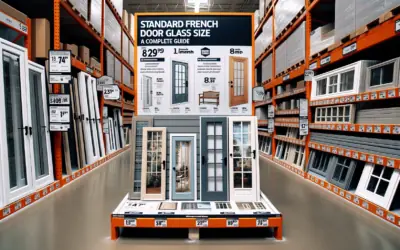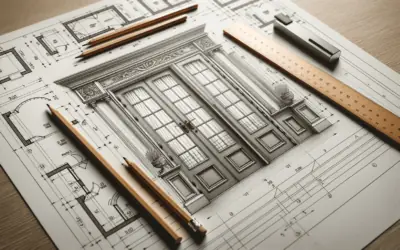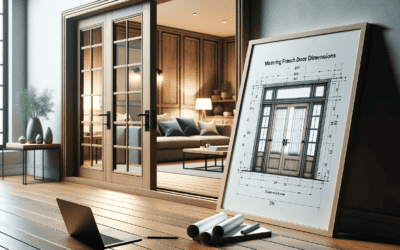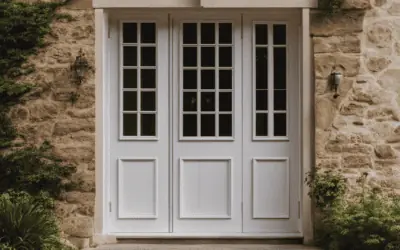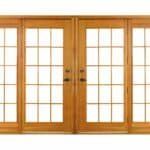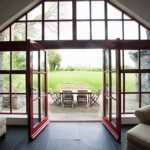
To assess the problem of your French doors blowing in the wind, identifying the cause and evaluating the severity of the problem can provide you with the necessary solution.
In the following subsections, we will briefly introduce you to the identifying process and the evaluation of the severity of the issue.
Identifying the cause of the issue
Analyzing the root cause of the issue is a crucial step in resolving any problem. By examining the underlying reasons for the problem, we can develop targeted and effective solutions. This process involves delving deep into the possible causes of the issue and gathering information that can help us identify and isolate its source.
Once we have gathered this information, we can use it to develop hypotheses about what might be causing the issue and begin testing those hypotheses through a variety of methods, including observation, experimentation, and analysis. By systematically examining each factor that could be contributing to the issue, we can gradually narrow down our focus until we arrive at a clear understanding of what is causing it.
It is important to note that multiple factors may be at play in any given situation, making it necessary to conduct a thorough investigation and evaluate all potential causes before settling on one or more likely culprits. Effective problem-solving requires attention to detail and careful consideration of all available evidence.
Ultimately, by taking a comprehensive approach to identifying the underlying causes of an issue, we increase our chances of finding a lasting solution that addresses not only the symptoms but also their root cause(s). In light of these considerations, businesses should invest time and resources to develop robust problem identification and assessment strategies emphasising rigorous analysis and evaluation.
Evaluating the severity of the problem
Analyzing the gravity of the issue at hand requires a meticulous approach towards assessment. Proper evaluation is essential to get to the root of any situation and find an adequate solution to it. The importance of analyzing the severity of the problem lies in discerning its impact on various aspects, including time, resources, and individuals involved.
To evaluate the severity precisely, one should take into account all relevant factors that contribute to the problem. These components include identifying past incidents, future risks, and potential solutions. A systematic approach can help determine where exactly things went wrong and how they can be rectified effectively.
In addition to analyzing past and present data, unique factors such as cultural background, mindset, and social systems can also affect the extent of complexities in resolving an issue. Therefore, gaining insight into these issues may provide clues in shedding light on new strategies.
Possible recommendations must be suggested based on complete evaluation findings to address concerns effectively. It is crucial to select solutions based on their effectiveness level along with their feasibility within regarded platforms. Carefully implementing recommended strategies can provide a positive outcome for everyone involved.
Thus, thorough evaluations play a significant role in addressing issues efficiently and formulating effective resolutions that reduce lengthy procedures while minimizing future occurrences of similar problems.
Adjusting the Door
To adjust your French doors blowing in the wind, tighten the hinges, check the alignment, install weatherstripping, and use draft stoppers. These sub-sections offer solutions to ensure that your French doors remain closed and secure, protecting your home from drafts and other weather-related issues.
Tightening the hinges
When adjusting a door, it may be necessary to tighten the hinges to ensure proper alignment. This can be done by following a simple three-step guide:
- First, inspect the hinges and identify any loose screws.
- Use a screwdriver to tighten each screw, being careful not to over-tighten as this could strip or damage the threading.
- Test the door to ensure it is properly aligned and adjusted.
It is important to note that if replacing screws, make sure they are the correct size and fit for your particular door and hinge. Additionally, regularly checking and maintaining your door hinges can prolong their lifespan and prevent future issues with alignment or movement.
Pro Tip: If tightening the hinges does not solve the problem, it may be time to consider replacing them altogether.

Checking the alignment
To ensure the door is functioning properly, it is essential to assess its alignment. Checking the placement of the door frame and hinges and identifying any gaps or inconsistencies can help determine if adjustments are necessary. A misaligned door can lead to issues such as air leaks and difficulty with opening and closing the door.
Adjusting the hinges can often resolve alignment issues. Tightening or loosening specific screws can shift the positioning of the door. Adding shims or adjusting the strike plate can also help correct any gaps in the opening. Adjustments should be made in small increments to avoid causing further alignment issues.
Additionally, it’s important to check for any obstructions that may be preventing proper alignments, such as debris on the hinge pins or an uneven floor surface. Regular maintenance and cleaning of these areas can prevent misalignments from occurring.
By regularly assessing and making small adjustments as needed, doors will function properly and provide more efficient energy usage while also avoiding potential future problems. Keep the weather out and your sanity in with some easy-peasy weatherstripping installation.
Installing weatherstripping
Weatherstripping Installation Guide
Installing weatherstripping is a must to improve your home’s energy efficiency and reduce air leakage. It helps seal gaps between the door frame and the door, stopping hot or cold air from entering or leaving a room.
Four Steps to Installing Weatherstripping:
- Measure – Use a tape measure to determine the length of weatherstripping you will need for your door.
- Cut – Use scissors or a utility knife to cut the required amount of weatherstripping material.
- Apply – Peel off the adhesive backing on one side of the weatherstrip and press it firmly onto the inside of the door frame.
- Test – Close the door to check if there are any gaps between the door and the frame. If necessary, trim any excess weatherstripping with scissors or a utility knife.
Additional Tips:
- Choose to weatherstrip made from foam, vinyl, or felt materials for best results.
- Check your door regularly for wear and tear in weatherstripping and replace it as needed to keep your home energy-efficient.
Pro Tip: Installing Weatherstripping can be an easy DIY task following these simple steps, but if you do not feel comfortable doing so, consider hiring a professional to help install them.
Draft stoppers are like exes; they always find a way to sneak back in and ruin your cozy night in.
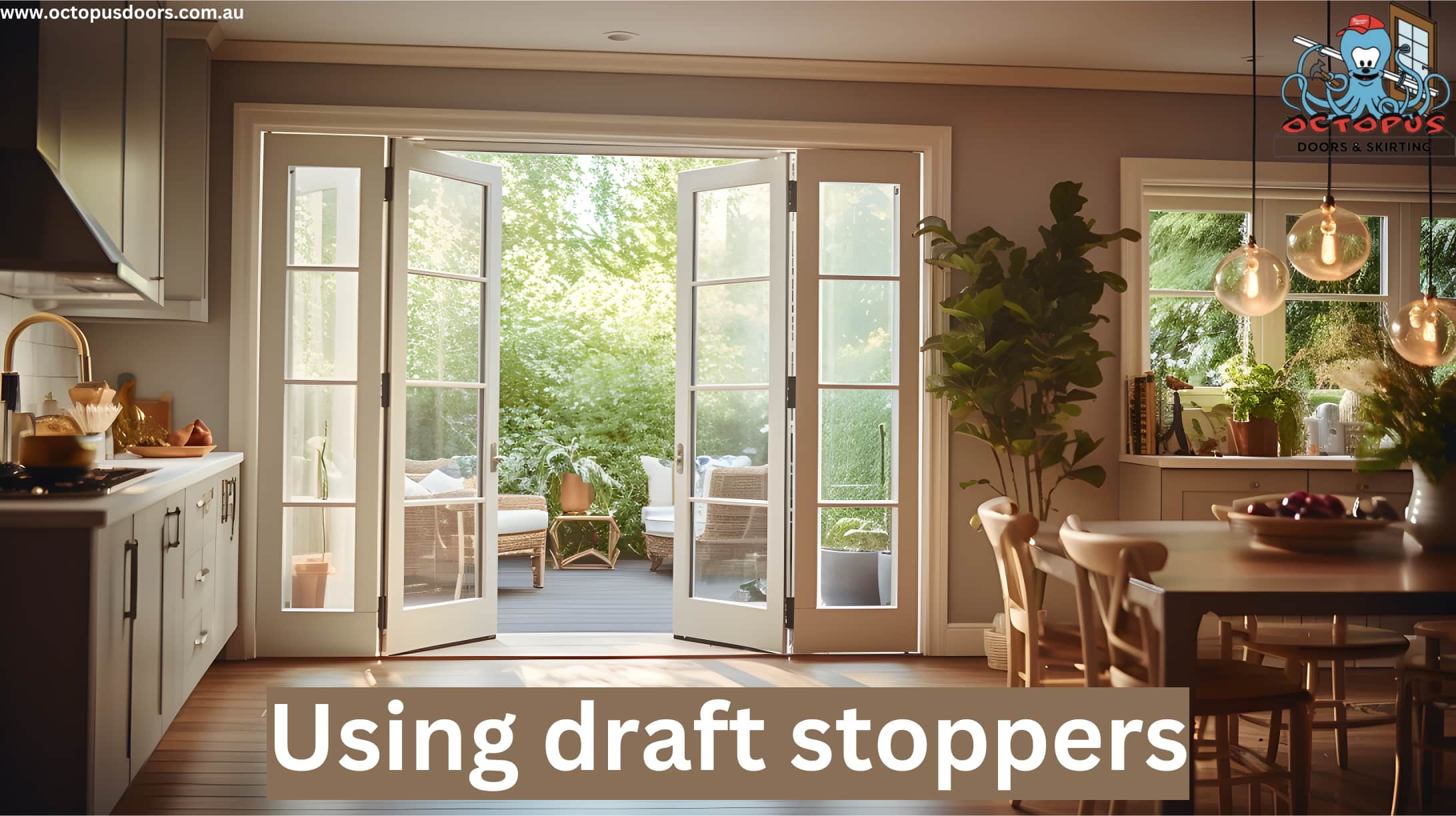
Using draft stoppers
Installing Door Draft Stoppers
Sealing the gaps around doors is an effective way to prevent draft and temperature fluctuations inside a room. Here’s how to install door draft stoppers in a few simple steps:
- Choose the appropriate type of draft stopper for your door, such as adhesive strips or weighted fabric rolls.
- Clean the bottom surface of your door thoroughly to remove any dirt or debris.
- Measure the length of your door and cut the draft stopper material accordingly.
- Apply the adhesive or attach the stopper with screws, depending on the type of stopper you choose.
Properly installing a draft stopper can save energy by preventing conditioned air from escaping through leaks around your door. In addition, be sure to check for any other sources of drafts or leaks throughout your home to maximize energy efficiency.
Did you know that according to Energy.gov, sealing air leaks in doors and windows can save up to 10% on annual energy bills? Who needs therapy when you can add support to your door?
Adding Support
Adding support is the best solution to ensure the stability of your French doors in windy conditions. In this section, “Adding Support” with “Installing a door stopper, Adding a door brace, Installing a wind chain” as solutions, we will briefly introduce the sub-sections that can help prevent your doors from blowing in the wind.
Installing a door stopper
Adding Support
Looking to secure your open door? Here’s a simple way to do so.
- First, select and purchase an appropriate door stopper that matches your decor.
- Clean the area where you plan to install the door stopper thoroughly.
- Next, locate a suitable position for the door stopper on the wall near the door handle or knob.
- Ensure that the surface is flat and place the door stopper there.
- Finally, use screws or adhesive tape to attach it tightly to the wall.
A firm and secure stopper provides peace of mind and enhances safety by preventing unwanted entry or exit through your doors.
Did you know that door stoppers were used in ancient Rome as well? They were known as “obelisks” and were mainly used for decorative purposes.
Lock your door and let the brace do the heavy lifting because sometimes you need a little extra support.
Adding a door brace
This section discusses fortifying a door using a support mechanism. To add this support, you can follow these four steps:
- Choose a door brace that fits the size and design of your door.
- Place the bracket against the frame where you want to add the support, then mark the holes for installation.
- Drill the holes into the frame, then attach the bracket securely.
- Place the pin through the bracket and into the hole on your door.
One important aspect to consider is ensuring a strong and durable brace is installed properly to avoid any unforeseen accidents. It is essential to use sturdy equipment and correct placement for satisfactory results.
A friend of mine recently shared how they added additional support to their door by adding extra brackets in strategic locations. This enabled them to reinforce their existing brace system, which provided increased security measures while ensuring safe egress in case of emergencies.
Better add that wind chain before your house becomes a kite!
Installing a wind chain
A wind chain can be installed to provide additional support to secure a structure from windy conditions.
A 3-Step Guide on How to add wind chain support:
- Start by measuring the length of the area where the wind chain will be installed.
- Purchase a suitable wind chain and attach it using anchor bolts.
- Test the strength by giving a pull before finalizing and tightening the anchor bolts.
Additionally, ensure that you do not over-tighten the anchor bolts as they may cause damage to the structure or even keep it too rigid during tremors.
Pro Tip: Remember to check periodically for any rust or cracks in the wind chain and replace it if required to avoid any mishaps.
Adding support is like trying to fix a sinking ship with a band-aid, but luckily there are additional solutions to reinforce the hull.
Additional Solutions
To address the problem of your French doors blowing in the wind in addition to the primary solution, which is adjusting door components, installing glass panels, building a windbreak, and planting windbreak trees or shrubs can be considered. This section explains these additional solutions briefly for you to explore and choose the one that fits your situation best.
Installing glass panels
Glass Panel Installation: A Professional Guide
Installing glass panels can be challenging, requiring attention to detail and expertise. To ensure its proper installation, it is essential to follow some steps carefully. Follow the step-by-step guide given below:
- Measure the space where you want to install the glass panel
- Choose the type of glass according to your needs and preferences
- Ensure that the edges are smooth and free from any debris or sharp edges
- Apply sealant on both sides of the glass panel’s edges
- Place the panel in the designated spot and apply pressure gently to ensure a tight fit.
- Let the sealant dry for 24 hours before using it.
Unique Details:
Ensure that you have appropriate safety gear while installing glass panels, including gloves, eye protection, and a respirator mask. Check with your local authorities if there are any specific codes on how to handle glass panel installation.
Suggestions:
Before installation, clean your workspace thoroughly by removing objects that may obstruct your work area. Use high-quality sealant for durability and safety purposes, as it prevents cracks from developing on the surface, which may lead to injuries or accidents over time.
Building a windbreak
To mitigate wind and protect the environment, a potential solution is creating a barrier that we could recognize as “Developing a Windbreaker.”
The following are the steps to be followed:
- Select A perfect location.
- Know Your Windbreak Goals.
- Choose what type of trees you want to plant.
- Food Plot Planting Schemes.
- Care and Maintenance.
To gain optimal results when constructing a windbreak, it is crucial to consider density and diversity. Density will encourage better filtering, while variety can adjust the structural capacity to withstand weather changes.
Don’t let the wind blow you away – plant some trees and shrubs as windbreakers unless you’re into extreme kite flying.

Planting windbreak trees or shrubs
For Maintaining A Wind-Free Zone
Planting of wind-restraining shrubs or trees is an effective way to mitigate the impact of heavy winds, which can cause significant damage to homes and infrastructure. When correctly positioned, putting up wind-restraining shrubs or trees provides a stable buffer against strong winds and can cut off about half the wind speed.
To plant your own windbreak trees or shrubs, you should:
- Identify the direction and strength of the wind
- Select appropriate trees such as pine, spruce, fir and deciduous species.
- When planting, the distance between each tree should be two to five times the height of matured trees to deliver maximum efficacy.
Choosing suitable plants that will thrive in local soil and weather conditions is essential. After planting, proper supervision should ensure that these shrubs are kept healthy with regular watering, fertilizers, pruning and pest control.
As a unique detail, it’s advised that before taking on this process, property owners should fully research approved species with a reputable horticultural expert regarding which types may fit appropriately for their area.
Some professionals also recommend installing mesh barriers perpendicular to prevailing winds to decrease airspeed below the level of precise injury. Another suggestion is to plot alternative land areas on their homesteads where vegetation could expedite natural defences against high winds’ potential adverse impact. By doing so, property owners expose themselves less than exposed fields.
Maintenance is like a box of chocolates – you never know which machine will break down next.
Maintenance
To maintain your French doors and keep them from blowing in the wind, the solution lies in regularly checking and adjusting the door, maintaining weatherstripping and draft stoppers, and cleaning and lubricating the hinges. These sub-sections will be explained in detail to help you maintain your French doors and prevent them from getting damaged due to the wind.
Regularly checking and adjusting the door
Regularly Maintaining the Door:
It is imperative to ensure the optimal functioning of entryways and exit points. Follow these five simple steps to check and adjust doors routinely:
- Inspect hinges and screws for any loose ends or damage. Tighten or replace as necessary.
- Clean the tracks and rollers of sliding doors, and lubricate them if needed.
- Check door seals for cracks or gaps that need sealing with weatherstripping, silicone, or rubber gaskets.
- Examine doorknobs and locks for wear. Coat the keys in lubricating spray before testing them out on lock cylinders.
- If necessary, conclude by tweaking and adjusting door-aligning mechanisms smoothly.
One must keep an eye open for subtle signs of deterioration on Door Stoppers and Hinges Too.
Lastly,
A friend was telling me about how one time he was struggling with a warped front door, unable to secure enough insulation from external variables into his dwelling because they were moving so frequently. He told me how no amount of greasing could make it slide up against the seal smoothly – but then he thought maybe stuff like jacking it up discreetly at certain angles (using temporary wedges) near each shim point (a bit like door frames) might be helpful. Despite its awkwardness, it instigated a conversation with another mover who knew exactly what he was talking about!
Sealing your home against drafts is like putting a sweater on your house – it’s cozy and energy-efficient.
Maintaining weatherstripping and draft stoppers
Weatherstripping and draft stoppers require consistent upkeep to ensure optimum performance. Proper maintenance of these seals can save energy costs and prevent air leaks.
To maintain weatherstripping and draft stoppers, follow these three steps:
- Inspect the seals regularly for any damages or cracks.
- Clean the seals with soap and water to remove any dirt or grime.
- Apply silicone lubricant to keep the seals flexible and prevent them from drying out.
It is vital to note that using petroleum-based lubricants on rubber seals will damage them. Also, avoid using abrasive cleaners as they may weaken the seal’s material.
In addition, replacing weatherstripping or draft stoppers after detecting extensive wear and tear is essential for optimum insulation.
According to Energy Star, sealing air leaks throughout a home can save homeowners up to 20% of their total energy costs.
So, don’t let damaged weatherstripping or draft stoppers cause air leaks in your home; regular maintenance can help prevent these issues. Don’t let rusty hinges bring you down, give them some love with a little clean and lube.
Cleaning and lubricating the hinges
Taking care of the movable parts makes it possible to keep the system running smoothly and extend its longevity. Here’s how to perform maintenance on hinges.
- Remove excess dirt using a soft brush.
- Clean the hinges by removing any grime buildup using warm water and soap.
- Wipe down with a microfiber cloth to avoid scratches.
- Lubricate the moving parts with a lubricant recommended by the manufacturer.
- Reinstall the hardware once everything has dried completely.
It is essential to perform this maintenance routinely, at least once every few months, depending on usage and location. Neglecting this step can cause harmful wear and tear, leading to hinge failure.
It is well known that moisture causes metals to rust, so it’s important to keep hardware dry if possible. Inland humidity levels reach as high as 90% in some areas, despite efforts to maintain internal climate settings and eliminate sources of moisture.
Source: National Oceanic and Atmospheric Administration (NOAA)
Maintenance may be a pain in the wrench, but it’s the only thing preventing your equipment from going out of nuts and bolts.
Conclusion and Recap
French doors are a design feature desired by many. However, they can pose a problem when windy weather strikes. This section will summarize key takeaways to help prevent French doors from blowing open.
- Install Door Stoppers: The simplest yet effective way is to install door stoppers as it holds the doors firmly and prevent them from swinging open.
- Fit Weather Stripping: Poorly fitting or damaged weatherstripping allows drafts into your home, which means that wind can come in under the door through gaps between the door and frame. Ensure to replace any striping that is damaged for better protection.
- Lock French Doors: Locking mechanism ensures your door stays put during windy weather, so remember also to fasten locking rods if your French doors have them.
- Add Draft Excluders: During the winter, when cold air comes on top, it’s essential to add draught excluders beneath French doors with external access to ensure air cannot flow inside.
In addition to the four key points offered in the previous paragraph, you need to check the hinges, where French doors can easily blow off if damaged or loose; hence, regular maintenance checks with the replacement of any broken parts will be helpful.
Don’t risk property damage and maintain safety by ensuring proper closure of your French Doors. Protect your homes now!
Frequently Asked Questions
Why do my French doors keep blowing in the wind?
French doors may blow in the wind if not properly installed, or the seals around the frame are damaged.
How can I stop my French doors from blowing in the wind?
You can stop your French doors from blowing in the wind by installing weather stripping, adding door sweeps, or adjusting the door hinges.
What are some signs that my French doors need to be fixed?
Signs that your French doors need to be fixed include difficulty opening or closing the door, drafts coming through the door, or visible cracks or gaps in the frame.
Should I attempt to fix my French doors on my own?
If you have experience with home repairs, you may be able to fix your French doors on your own. However, if you are uncomfortable making repairs, hiring a professional is best to ensure the job is done correctly.
Can I prevent my French doors with curtains or blinds from blowing in the wind?
Curtains or blinds may help to reduce drafts, but they will not necessarily stop your French doors from blowing in the wind. It is best to address the underlying issue by installing weather stripping or adjusting the door hinges.
How much does fixing a set of French doors that are blowing in the wind cost?
The cost to fix a set of French doors varies depending on the extent of the damage and whether you hire a professional. It is best to get a quote from a professional to determine the cost of the repair.
Related Articles:
15 Elegant French Door Inspirations to Elevate Your Bedroom Style
Your bedroom is the last thing you see before closing your eyes at night and the first thing that greets you each morning. Why settle for plain walls when you could wake up to the elegant silhouette of French doors framing natural light? These aren't just...
Charm and Elegance Unleashed: The Timeless Appeal of Timber French Doors
Timber French doors are a timeless architectural element that grace homes with elegance, natural warmth, and beauty. With their characteristic large glass panels surrounded by wide stiles and rails made of solid wood, these doors create an inviting transition between...
French Doors Buying Guide: An In-Depth Look
French doors are a popular choice for homeowners looking to enhance natural light, ventilation, and aesthetic appeal. With their characteristic large glass panes and narrow dividing frames, these elegant doors create an inviting indoor-outdoor flow. This comprehensive...
Standard French Door Glass Size: A Complete Guide
French doors are an elegant and timeless architectural feature known for their decorative glass panes that allow ample natural light into a space. But what are the standard glass sizes for these iconic doors? Understanding the typical dimensions of French door glass...
How Big Can French Doors Be in CM? A Complete Guide
French doors are a classic and elegant addition to any home. With their large glass panes and delicate dividers, they allow ample natural light into a space while providing a beautiful architectural focal point. But before installing these iconic doors, it's important...
Mastering French Door Dimensions: Your Ultimate Guide to Exterior Sizes
French doors are a classic and timeless architectural feature that can add elegance, charm and functionality to a home. As their name suggests, they originated in France but have been popular in the US and elsewhere for over a century. I'm a homeowner looking to...
What Are Active or Stationary French Doors
Welcome to our guide on active and stationary French doors! Picture this: you're standing in your home, longing for elegance and functionality. That's where French doors come in. These beauties consist of two door panels, one that swings open (the active side) and one...
How to Stop French Doors Slamming
French doors constantly slamming shut, causing frustration and potential damage? We've got you covered. With some maintenance and simple adjustments, you can prevent your doors from slamming and enjoy their beauty and functionality for years. Regular inspection and...
From Classic to Contemporary: The Impact of French Doors on Modern Architectural
Discover the impact of French doors on modern architectural design. From classic elegance to seamless indoor-outdoor flow, unlock the beauty of contemporary living.
The Architectural Impact of French Doors: A Historical Perspective
Discover the architectural influence of French doors! From Europe to America, their impact on design is unparalleled.
French Door Sizes: A Complete Guide to Standard and Custom Dimensions
As I step through the threshold of knowledge, let me guide you through the world of French door sizes. This comprehensive article explores the standard dimensions for exterior and interior French doors and the exciting possibilities of custom sizes. I'll also reveal...
How to Build Steps Outside French Doors
We've all dreamed of stepping onto a grand patio framed by elegant French doors. But how do we bring that dream to life? Building steps outside French doors takes careful planning and attention to detail. We'll guide you through the process, from determining the...
Message Us
Get In touch below. Ask Any Question or Start a Free Quote
Call Us
1800 491 492
I'm James Davis, a carpenter with eight years of experience in carpentry services, repairs, installations, renovations, and maintenance of interior doors. I have a diploma in carpentry and joiner trade from the Education Skills Australia Institute and take pride in delivering high-quality results to ensure customer satisfaction. I'm a blog writer for Octopus Doors Company and enjoy sharing my knowledge and tips on maintaining security measures and choosing the right door materials, paints, or handle styles. I specialize in custom-made interior doors and strive to make every home look fabulous. Contact me anytime for help with door-related issues.




